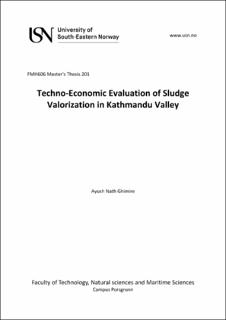| dc.description.abstract | The Bagmati River, revered as the cradle of the Kathmandu Valley civilization, holds profound cultural and religious significance. The rapid and unregulated urban expansion, coupled with the absence of adequate sewage collection systems and wastewater treatment plants (WWTPs), has transformed the river and its tributaries into conduits for sewage.
Anaerobic digestion (AD) accepted globally as a prominent stabilization method, offering resource recovery opportunities to enhance the financial viability of WWTPs. Nevertheless, a critical data gap exists in wastewater management within the Kathmandu Valley. This thesis addresses this gap by evaluating household wastewater generation from 2024 to 2044, considering parameters such as population, per capita water consumption, and sewer network coverage.
Additionally, a comprehensive plant-wide mass balance was conducted on a reference Activated Sludge Process WWTP to establish benchmark values, including per million liters per day (MLD) sludge generation, per MLD methane production, and per MLD organic manure production. Subsequently, an overall estimation of BioCNG and organic manure was derived based on wastewater generation data and mass balance benchmark values.
The study reveals that 299 MLD of wastewater will be generated in the Kathmandu Valley in 2024, increasing to 551 MLD by 2044. BioCNG potential for 2024 is estimated at 5701 kg per day, sufficient to fuel 73 public buses daily in Kathmandu Valley. The generated organic manure amounts to 61 metric tons, equivalent to 5% of the daily fertilizer import.
Furthermore, a financial analysis was conducted on an 80-tonnes-per-day AD plant processing sewage sludge. The results indicate a Net Present Value (NPV) of Rs 240,416,222, an Internal Rate of Return (IRR) of 6.2%, and a Payback Period (PBP) of 8 years.
This thesis establishes a technical and economic foundation supporting the integration and promotion of WWTPs coupled with AD plants in the Kathmandu Valley. This approach serves as an environmentally sustainable solution to preserve the Bagmati River basin and create a viable market for AD in the country. | |

